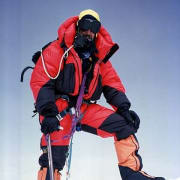The Antarctic Summer Ushers in Climbing Season on 7 Summit Mt. Vinson

The Antarctic Summer
The fall climbing season has ended in the Himalayas, home to the fourteen 8,000-meter peaks – the highest mountains in the world. While some ambitious mountaineers will attempt winter climbs on Himalayan peaks, the majority of expeditions will now travel to warmer climates and more accessible mountains. Mt. Vinson in Antarctica in the southern hemisphere attracts climbers every year seeking to climb one of the iconic Seven Summits – the highest mountain on each of the seven continents. (Related Article)
The Antarctic summer runs from November through March, when the sun is out 24-hours per day and temperatures hover around -18°C (0°F) – a relative balmy environment on the continent. These conditions facilitate climbing season on Mt. Vinson, the highest peak on the continent of Antarctica, standing 16,050 ft.
Mount Vinson
Mt. Vinson, part of the Sentinel Range of the Ellsworth Mountains near the Ronne Ice Shelf, stands 700 nautical miles from the South Pole. Mt. Vinson and five other nearby mountains are collectively called Vinson Massif.
In January 1967, a climbing team led by Nicholas Clinch from the American Antarctic Mountaineering Expedition summited Mt. Vinson for the first time. Since then, mountaineers from around the world have flocked to the frigid ice of Antarctica to scale Mt. Vinson, and notch one of the Seven Summits.
Climbing Mount Vinson (4,892 meters/16,050 feet), presents a unique and challenging endeavor, combining extreme cold, a remote location, and breathtaking polar landscapes. The journey begins with a flight to Union Glacier Camp, a logistics hub for Antarctic expeditions. From there, climbers take a smaller aircraft to the base camp of Mount Vinson.
The logistics required to get to the continent, and to base camp, present half the battle in climbing this mountain. The climb, while fairly straightforward, exposes climbers to extremely cold weather conditions. The elements add the defining hurdle to the climb.
Climbing Mount Vinson
Base Camp (2,130 meters/7,000 feet) Vinson Base Camp, set on the Branscomb Glacier, facilitates climbers acclimatization process and preparation for the ascent. Climbers typically spend a day or two here organizing gear and practicing glacier travel techniques.
Low Camp, or Camp 1 (2,743 meters/9,000 feet) The route to Low Camp involves a moderate ascent across the glacier. This sheltered camp serves as the first significant stop. Climbers set up tents and acclimatize while preparing for the steeper sections ahead.
High Camp, or Camp 2 (3,940 meters/12,900 feet) The more technical climb to High Camp requires the use of fixed ropes (in addition to mandatory climbing gear including ice axes and crampons) on a steep, icy slopes. High Camp, located on a windswept plateau, exposes climbers to freezing temperatures and strong winds. Climbers stay at High Camp to focus on rest, refueling and hydration before leaving as soon as possible for the summit push.
Summit Day (4,892 meters/16,050 feet) The summit climb involves steep, exposed snow slopes with temperatures often dropping below -30°C (-22°F). Weather conditions are critical, and clear skies are essential for a safe ascent. From the summit, climbers are rewarded with stunning views of the Antarctic plateau, a vast expanse of ice and mountains stretching to the horizon. After reaching the summit, climbers descend carefully, often returning to High Camp the same day. The return to Base Camp typically takes one to two days depending on weather conditions.
Professional Mountain Guiding Companies on Vinson
Several notable and elite mountain guiding companies conduct guided climbs on Mt. Vinson. I highly recommend the following accredited companies: Madison Mountaineering; Climbing The Seven Summits (“CTSS), Adventure Consultants; Alpine Ascents; International Mountain Guides (“IMG”); RMI Expeditions. I strongly recommend reaching out to any of these excellent guiding companies to assist with your climbing journey to Mount Vinson in Antarctica.
